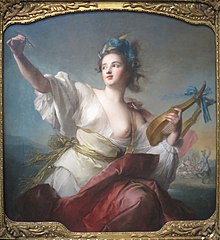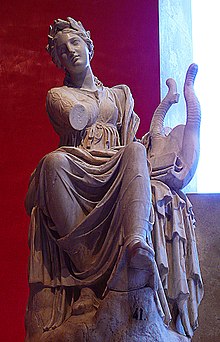Terpsichore
Jump to navigation
Jump to search


This article needs additional citations for verification. (May 2016) (Learn how and when to remove this template message) |

Terpsichore, Muse of Music and ballet, an oil on canvas painting by Jean-Marc Nattier (1739).
In Greek mythology, Terpsichore (/tərpˈsɪkəriː/; Τερψιχόρη, "delight in dancing") is one of the nine Muses and goddess of dance and chorus.[1] She lends her name to the word "terpsichorean" which means "of or relating to dance". She is usually depicted sitting down, holding a lyre, accompanying the dancers' choirs with her music. Her name comes from the Greek words τέρπω ("delight") and χoρός ("dance"). She was also said to be the mother of the Sirens and Parthenope by Achelous. In some accounts, she bore the Thracian king Biston by Ares.[2]
In popular culture[edit]
Historical[edit]
- The British 32-gun frigate HMS Terpsichore (1785) commanded by Captain Bowen participated in the Battle of Santa Cruz de Tenerife (1797).
Places[edit]
- Terpsichore is the name of a street in New Orleans' historic neighborhoods of Faubourg Lafayette and the Lower Garden District. It runs alongside Euterpe and Melpomene streets, also named for Greek muses.
- Terpsichorean is the name of the Choreography Society of Hans Raj College, University of Delhi.
- Terpsichore is the name of the Mississippi State University Dance Theatre Company in Starkville Mississippi.
Literature[edit]
- Terpsichore figures among her sisters in Hesiod's Theogony.
- When The Histories of Herodotus were divided by later editors into nine books, each book was named after a Muse. Terpsichore was the name of the fifth book.
- The character of Wilkins Micawber, Esq, Jr. is described as a "votary of Terpsichore", in an Australian newspaper brought to London by Dan Peggotty in 1850 novel David Copperfield by Charles Dickens.
- T. S. Eliot in the poem Jellicle Cats from Old Possum's Book of Practical Cats (1939), refers to the "terpsichorean powers'" Jellicle Cats as they dance by the light of the Jellicle Moon.
- Terpischore "Choral Dance" is the name of a chapter in Theresa Cha's Dictee.
- "Some Terpsichore" is the title of a short story in a 2014 book, Thunderstruck and Other Stories, by Elizabeth McCracken.
- Terpsichore is referenced in George Orwell's first novel Burmese Days in a dialogue by one of the minor characters, Mr Macgegror.
- Terpsichore Station is the name of a mining facility in the Star Wars novel "Phasma" by Delilah S. Dawson
Music and dance[edit]

Augustin Pajou, The Muse Terpsichore, c. 1768, red chalk on laid paper, in the collection of the National Gallery of Art, Washington, DC.
- "Terpsichore" is the title of a large collection of dance tunes collected by Michael Praetorius, some originating with Pierre-Francisque Caroubel and some later adapted for wind ensemble by Bob Margolis.
- Terpsichore is also found in François Couperin's "Second Ordre" from the Pièces de clavecin, and in the third version (HWV 8c) of Handel's opera Il pastor fido (1712). This opera is sometimes referred to as Terpsicore and Il pastor fido.
- The Jimmy Van Heusen/Sammy Cahn song "Come Dance with Me" (popularized by Frank Sinatra) includes the lyric "what an evening for some Terpsichore." However it is sung as a three-syllable word with the "chore" component pronounced like "core" (to rhyme with "for") rather than "curry".
- The Russian singer Origa sings a song, "Tersicore".
- Canadian punk band Gob has a song called "Terpsichore" on their album Apt. 13.
- The eighteenth century French dancer and courtesan Marie-Madeleine Guimard named the private theater in her private palace (1766) the Temple of Terpsichore.
- Terpsichore in Sneakers is the title of a 1980 study of postmodern dance by dance historian and critic Sally Banes.
- The song "Terpsichora" is included on J-Pop singer Akiko Shikata's 2007 album Istoria: Musa.
- The album Cool by Bob James and Earl Klugh features a track called "Terpsichore".
- In the art of the Russian rockband "Splean" is the eponymous song
- Herbie Nichols composed a song called “Terpsichore“ on his Blue Note recordings.
Media[edit]
- In the 1936 feature film Swing Time starring Fred Astaire and Ginger Rogers, Lucky (Astaire), when asked by Mr. Gordon why he wishes to learn to dance, answers: "To flirt with Terpsichore". He then proceeds to take a dance lesson with Penny (Rogers), culminating in a paired tap routine.
- In the 1947 film Down To Earth, Rita Hayworth plays Terpsichore, who is annoyed and visits Earth to change a musical that depicts her in a bad light.[3]
- In the 1948 musical comedy film April Showers, starring Jack Carson and Ann Sothern, Carson plays a Victorian-era vaudevillian. While performing an act with his son, Buster (played by Robert Ellis), Buster asks "Shall we dance, Mr. Lovejoy?", Carson replies by saying "Terpsichore, Mr. Gay!"
- In the 1969 Western film McLintock!, Drago (Chill Wills) introduces an exhibition of new dance steps as Terpsichorean.
- Olivia Newton-John plays the muse Terpsichore as "Kira" in the 1980 film Xanadu, a remake of Down To Earth.[4]
- Terpsichore is featured as a character in the 1997 Disney animated film Hercules.
- In the 1961 Gunsmoke episode "Old Yellow Boots", Doc (Milburn Stone) boasts to Chester (Dennis Weaver) that in his younger days he was known as "the terror of Terpsichore".
- In an episode called "Quick-Quick Slow Death" of the UK crime agent series The Avengers, a dance institute is called Terpsichorean Training Techniques Inc.
- The Terpsichorean Muse is referred to by John Cleese in the Cheese Shop sketch of Monty Python's Flying Circus.
- The fifth season episode of Xena: Warrior Princess, "Lyre, Lyre, Hearts on Fire", centers around a battle of the bands for Terpsichore's Lyre.
- Terpsichore is a technique used by the royal guard Neferpitou to "dance past one's limits" in the manga Hunter × Hunter.
- In the Les Luthiers' Unen canto con humor comedy show is referred in a sketch by Daniel Rabinovich and Marcos Mundstock, but Daniel improperly pronounces her name, calling her "Esther Píscore".
- Terpsichore is one of the legendary "Mythic Weapons" obtainable in Final Fantasy XI, only equipped by the Dancer class.
- The Onyx Terpsichore is a weapon of the Hunting Horn class in 2015's Monster Hunter 4 Ultimate for Nintendo 3DS.
- In an episode from 1966 called "Space Circus" of the US science fiction series Lost In Space, the character of Dr. Zachary Smith, whilst preparing to rehearse for an audition with an alien circus troupe, refers to his intention to make use of the "art of Terpsichore" after deciding to let the character of the robot sing instead of him, thus leaving him free to concentrate purely on dancing.
- In the 2011 animated movie Rango, when attempting to steal a huge jug of water back from a clan of rodents, the titular Rango has his posse disguise themselves as members of "Madame Lupone's Terpsichorean Troupe of Traveling Thespians" to try and lull the rodents into a false sense of security, with their ruse including them dancing around in costumes.
- In the April 7, 2006 Season 2, episode 19 "Dark Matter" of Numbers, Larry Fleinhardt (Peter MacNicol) offers Special Agent Megan Reeves (Diane Farr) "maybe even some Terpsichorean pleasure" as an option for a potential date. She responds, "I don't know what [that] means, but dinner sounds nice."
See also[edit]
- Muse
- Muses in popular culture
- The asteroid 81 Terpsichore
References[edit]
- ^ Theoi Project, Greek Mythology, Muses [1], Retrieved April 29, 2014
- ^ Etymologicum Magnum, 197. 59 s. v. Bistoniē
- ^ "New Flower Named For Rita Hayworth". Pittsburgh Post-Gazette. Pittsburgh, Pennsylvania. August 29, 1946. p. 15. Retrieved May 2, 2016.
- ^ Ross, Robert Alan (August 23, 1980). "'Xandau' is a pale imitation of old musicals". St. Petersburg Times. St. Petersburg, Florida. p. 5B. Retrieved May 2, 2016.
External links[edit]
 Media related to Terpsichore at Wikimedia Commons
Media related to Terpsichore at Wikimedia Commons- Warburg Institute Iconographic Database (ca 40 images of Terpsichore)
